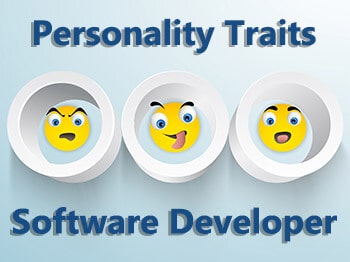What You Need to Know to be a Backend Web Developer
 You will find generally two parts to any web application: the front end, or client side, and the back end, or the server side. The front end includes the web pages you see and interact within your browser. Those pages are generally designed by front-end developers. However, the major portion of the application remains hidden. This is the elusive and mystical “back-end.”.
You will find generally two parts to any web application: the front end, or client side, and the back end, or the server side. The front end includes the web pages you see and interact within your browser. Those pages are generally designed by front-end developers. However, the major portion of the application remains hidden. This is the elusive and mystical “back-end.”.
The backend of a web app is actually a helper for a frontend. An application’s frontend could be the most magnificently built web page, but if the app itself does not work, the app will be a failure. That is why the backend development needed an extra attention to make things work. But you may be wondering what the industry is like for backend developers?
With the IT sector growing at a rapid rate, many organizations want to hire developers having the expertise of both front-end and back-end technologies. As it will minimize their workload of having to employ a different developer both for front-end and back-end development.
However, when it comes to hiring an IT professional in a particular domain, backend developers are usually paid more. And also, you will find more job opportunities available for backend developers contrary to frontend development. So let us discuss in depth what you need to know to be a backend web developer.
What is backend development?
Consider back-end development to be any type of development which does not involve creating a user interface. This could cover back-end web development, however, it may also require writing APIs, creating libraries, or dealing with pieces of systems that do not have user interfaces or even systems of scientific programming.
What back-end developers do can differ significantly with respect to the scope as well as the size of the application they are working on. There are many jobs where you will be working as a back-end developer, taking care of the business logic in an application, and feeding and retrieving data from the front-end.
What is the difference between front-end and backend?
Both of these terms are thrown around a lot in the web world. It can be a little annoying because the difference relating to the front-end and back-end isn’t always properly clear. They are terms frequently used to explain components of the web industry. The front-end is also referred to as the client-side as well as being often regarded as “web design”. The back-end of the web world is normally referred to as server-side. Generally when somebody says they are a “web developer” they are saying they work with the back-end of web applications.
The front-end is everything associated with what the user sees, consisting of design and a few languages like HTML and CSS.
The back-end, or the “server-side”, is actually the way the site works, updates and changes. This identifies all the things the user cannot observe in the browser, like servers and databases. In most cases, people that work with the back-end are known as developers or programmers. Back-end developers are pretty much concerned about things like structure, security and content management. They generally know and can make use of languages like HTML and CSS, but that is not really their focus.
APIs:
The backend or the script-side of a dynamic web application which works on request-response architecture consists of API’s, frameworks, databases, service workers and an operating system. So what is an API(Application Programming Interface)?
A site relies on a URL address to make a call to a server and pull up a webpage in the browser. APIs also conduct calls to a server, however, they do it more simply. They connect the web, enabling developers, applications, and sites to make use of databases and services (or, resources)—much like open-source software. APIs do that by working like a universal converter plug providing a standard set of instructions.
What kind of education do you need?
Do you need a formal education?
The most typical degree held by back-end developers is Computer Science. 11% had a degree in CS before turning into back-end developers. Many companies require back-end developers to possess a bachelor’s degree in computer science or a similar subject. Sometimes, companies may choose candidates with a master’s degree. Back-end developers should have a high degree of technological experience and knowledge using database systems and programming languages. Training in languages such as Python, understanding of Oracle, familiarity with SQL Server and know-how using Unix might be wanted by companies. But can you become a backend developer without getting a formal education? The answer is ‘Ofcourse you can!’. Formal degrees can be an advantage in getting a job but are not compulsory. So how can you become a backend developer with having a degree? Let’s discuss.
What are your options to learn without formal education?
The unique thing about web development is that basically all the learning materials you ever need can be found FREE online, there’s nothing you can’t learn on your own without dealing with 4-yrs of college and getting a CS degree. But having a CS degree won’t hurt, particularly when you are not sure what to do or lack the expertise to get a developer job.
In terms of getting a job as web developer, the most significant thing is your portfolio, e.g. the open source projects you contributed to, your GitHub account, well-designed personal projects you built … etc. When it comes to hiring, CS degree is great, but it is likely to have a really low signal on a candidate’s ability, many individuals have CS degrees yet they are still an average developer.
You can consider joining online courses and boot camps. And spend 9-12 weeks gaining knowledge of only web development, you can study all you need to know about building web apps. But avoid spending too much time only on learning (online, books…etc) without building things. Programming is an art, it requires practices, many hours of practices to get good at. Meet different developers, and perhaps work with them on a few projects. And here is a must do, get a Github account, contribute to some open source projects, or open source some of your own works. The Github portfolio is pretty much a programmer’s resume these days.
How is the Job marked for backend developers?
As discussed in the start that backend developers earn more then frontend developers, but how much are they making? As mentioned in PayScale, the countrywide average starting salary for back-end developers is around $70k. The salary varies from about $33k-$105k depending on location, experience, and industry. As stated by SimplyHired, in NYC, the starting salary is around $87k with approximate range to $120k.

What is a typical day for a backend developer?
A typical day as a backend developer will be far from routine because you’ll often be solving problems as they come up. Here is an example of a typical workday of a backend web developer:
- When you arrive at the office, you may want to check logs to see if any of your company’s or your client’s website hasn’t had any problems during the night.
- You often need to appear in team meetings to plan ongoing projects, discuss issues and difficulties and plan the day ahead.
- The next few hours will be spend coding on the current project. You will pick the tasks which were discussed at the team meeting and implement it in your solution.
- After lunch, you might have gotten some support cases from customers. This could be critical bugs you need to fix right away, or it might be some issue the customer didn’t understand which you need to sort out.
- On a typical day, you should squeeze in some studying. It is important for you as a developer to keep yourself updated so you are better equipped to create better web apps in the future.
- You may want to collaborate with frontend developers to review the functionality of a module, and how data will be fetched at frontend. You’ll need to ensure that all required communication between server and client is working perfectly.
- At the end of the day, it’s a good idea to review the day’s work, and possibly test your website modules one more time.
Is it possible to be a freelance backend developer?
 A backend web developer can go with the typical job, doing work for just one organization, for a regular salary, or to freelance. In the previous years, freelancers made more income than the others. It was because they were experts and worked on a short-term basis.
A backend web developer can go with the typical job, doing work for just one organization, for a regular salary, or to freelance. In the previous years, freelancers made more income than the others. It was because they were experts and worked on a short-term basis.
Making money even more than normal employees is still possible today. But the truth is, it takes more than one skill and hard work.
Excellent freelance career as mentioned above is a combo of skill, hard work, and strategy. The perception that freelancers just sit at home and jobs flow their way without struggle is a serious myth. Nothing good comes easy; all who wants to have it need to work at it. So, first, you should build some strong skills in backend development and then you are good to go with freelancing.
The different backend web development languages
The first step in backend web development is choosing a language for source codes. Here are some most common languages for basic backend development. Anyone who wants to learn backend development begins here. So let’s jump right in with the best choice.
1. JavaScript (Node.js)
JavaScript is considered the most popular language as mentioned in StackOverflow’s annual survey, with 62.5% of participants claiming to use it. It is doubtlessly the prominent language of the web as well as the growth of JavaScript in the last 10 years continues to be tremendous. Having that in consideration., it is safe to state you will see a good number of JavaScript opportunities in 2018 and beyond.
JavaScript expertise nourishes into lots of front-end frameworks including React, Angular, Backbone, Ember, and others, and also the Node.js run-time environment, that allows you to run JavaScript on the backend with high efficiency.
Pros of using Javascript + Node.js:
- Asynchronous event-driven IO allows concurrent request handling.
- npm, the Node-packaged modules have already grown to be giant and still growing.
- You can stream big files.
- Active and stunning community, with many different codes, shared via Github, etc.
- Share a similar piece of code with both client and server side.
Cons of using Javascript + Node.js:
- Working with a relational database is annoying if you are using Node.
- Node.js is not designed for CPU-intensive tasks.
Node.js Developer Salary:
The standard annual salary Node Js Developer throughout the U.S. is $115,023 a year.
A Node Js Developer annual pay ranges from $74,500 to $157,000 Countrywide. This little spread of $82,500 reveals Node Js Developer pays are seeing small difference throughout the country.
2. Python
Python is a general-purpose language that you can find nearly everywhere today. Python-based web development frameworks like Flask and Django have been earning ever more recognition. Also, the language is greatly pre-loaded with very good data analysis and machine learning libraries. On the whole, career paths with Python are several and here to stay. It’s a wise decision for beginner developers, as it is high-level and simple to learn and understand.
Pros of using Python:
- Python is easy to learn for even a novice developer.
- Object-Oriented Programming-driven.
- Python has a plethora of frameworks that make web programming very flexible.
- A large number of resources are available for Python.
- Supports multiple systems and platforms.
Cons of using Python:
- Python is slow
- Has limitations with database access.
- Not the best choice for memory intensive tasks.
- Has performance issues for multi-processor/multi-core work.
Python Developer Salary:
As indicated by Gooroo, a platform which delivers tech skill and salary statistics, Python is among the highest-paying languages in the united states. At $116,379 annually, Python programmers are the best-paid software engineers in the US.
3. Ruby
Ruby belongs to the most loved programming languages available. It is built to be friendly and simple to use by developers, as its own tagline is “a programmer’s best friend.”
Ruby is mainly used for its coolest framework — Ruby on Rails. It is a web framework which encapsulates each of Ruby’s ideas into a robust tool for the web.
Pros of using Ruby:
- Best Industry Standards
- Vibrant Community
Cons of using Ruby:
- Slow Runtime Speed and Performance
- The high cost of wrong decisions in development
Ruby Developer Salary:
The average annual pay for a Ruby Developer Across the U.S. is $111,641 a year. A Ruby Developer annual salary ranges from $34,000 to $182,500 nationally. This small spread of $148,500 indicates Ruby Developer salaries are seeing little change across the country.
4. PHP
PHP has a wonderful scope in the present technological era. CMS like WordPress, Joomla is giving it an additional push into the industry and are holding the top position in the Blogging Market. As well as a lot of people use these cms to create great websites as so many websites are being created with PHP, so can get good orders not only for new sites but to maintain old sites too. Even, companies choose PHP as it produces more effective and dynamic web solutions.
Pros of using PHP:
- PHP is compatible with a full range of platforms
- Large Open Source Software Community
- A Multitude of Pluggable Frameworks
- Accessible and available for free
- Low Barrier of Entry
Cons of using PHP:
- Interpreted Language
- Requires more resources
- Executes more slowly than most other languages
PHP Developer Salary:
The average PHP Developer salary in the USA is $77,320 per year or $40 per hour. This is around 2.7 times more than the median wage of the country. Entry-level positions start at $54,000 while most experienced workers make up to $108,000.
5. JAVA
Java is arguably the most famous programming language as 90% of the Fortune 500 companies heavily utilize it. Its well-known slogan “write once, run anywhere” catches the important thing which makes Java so useful. However, not the most “trendy” language right now, Java is so heavily used that we can pretty much assure it will not go anywhere in the next 10 years and beyond.
Due to this, you can be comfortable that you have lots of Java job positions both in your city and remotely.
Pros of using Java:
- Does not slow your computer speed
- Free
- Java (the platform) has a very large and standard class library, some parts of which are very well written.
- The syntax is familiar to the myriad programmers that know any other C based language.
Cons of using Java:
- Security issues have tainted Java’s reputation
- Verbose and complex code
- Poor performance
Java Developer Salary:
According to PayScale, the average salary for a Java developer is $69,722 per year, with an average salary range of $47,169 to $106,610 per year. The highest paid Java developers are in San Francisco and Arlington, where the average reported yearly salaries are $97,000 per year.
What kind of databases is used in the industry?
 Even though database management systems all execute the same simple task, which is to allow end users to create, access and edit information in databases, the way in which they achieve this can vary. There are numerous well-known databases systems available in the market – both free and paid. To help you choose which database management system could be best for you, have a look at the list below of some popular databases used in the industry.
Even though database management systems all execute the same simple task, which is to allow end users to create, access and edit information in databases, the way in which they achieve this can vary. There are numerous well-known databases systems available in the market – both free and paid. To help you choose which database management system could be best for you, have a look at the list below of some popular databases used in the industry.
MySQL
MySQL is among the most preferred databases for web-based applications. This database engine enables you to choose from a number of storage engines that allow you to adjust the functionality of the tool and deal with data from different table types. Furthermore, it has a user-friendly interface, and batch commands will let you process large numbers of data. The system is also extremely dependable and does not usually hog resources.
Pros
- It is free.
- There are a number of user interfaces which can be applied.
- It provides a lot of features even for a free database engine.
- It can be used with other databases, like Oracle and DB2.
Cons
- You may spend a lot of your time and energy to get MySQL to perform things that other systems accomplish on auto-pilot, like making gradual backups.
- Support is available for the free version, but you will have to pay for it.
- You cannot find any built-in support for OLAP or XML.
MongoDB
One more free database that also offers a commercial version, MongoDB is made for applications involving both structured and unstructured data. The database engine is really flexible, and it works by linking databases to apps via MongoDB database drivers.
As MongoDB was not made to deal with relational data models, although it can, performance problems are likely to appear if you try to use it in this way. Even so, the database engine is built to manage variable data that is not relational, and it can often work effectively where other database engines have difficulty or fail.
Pros
- It is quick and simple to work with.
- Data of any structure can be stored and accessed easily and quickly.
- The schema can be created with no downtime.
- The engine works with JSON and also other NoSQL documents.
Cons
- SQL is not used as a query language.
- Setup can be a long procedure.
- Default configurations are not secure.
- Tools to help you convert SQL to MongoDB queries can be found, however, they put an additional step in making use of the engine.
Oracle
It is not surprising that Oracle is consistently on top of lists of famous databases. The initial version of this database management tool was developed back in the 70s, and there are several editions of this software on the market to meet your application’s requirements.
A few of the top features of the latest version of Oracle include a grid framework and the utilization of both logical and physical structures. Which means that physical data management does not have any impact on access to logical structures.
Pros
- You will get the newest features and innovations via their products as Oracle has a tendency to set the bar for other database management tools.
- Oracle database management tools are also very powerful, and you can pick one that can perform almost anything you can possibly think of.
Cons
- The system can need heavy resources once installed, so hardware upgrades may be needed to actually use Oracle.
- The price of Oracle can be too high, specifically for smaller businesses.
SQL Server
Just like other well-known databases, you are able to choose from several versions of Microsoft SQL server. This database management engine works on cloud-based servers and also local servers, and it can be put together to work on both simultaneously.
One of the outstanding features for the latest release consist of temporal data support, that makes it practical to track alterations made to data with time.
Pros
- It is quite fast and stable.
- It is also possible to access visualizations on mobile devices.
- It works perfectly with other Microsoft products.
- It provides the ability to change and monitor performance levels, which can lessen resource usage.
Cons
- Enterprise pricing may be above what most businesses can afford.
- A lot of people have problems using SQL Server Integration Services to import files.
- Despite having performance tuning, Microsoft SQL Server can gobble resources.
Graph Databases
Graph databases solve the disadvantages of relational databases for modeling and querying complex relationships. They see relationships as a separate object to attain the top-notch performance and boost the readability of the data model.
Pros
- Really fast queries if you are interested in relationships between nodes.
- Can facilitate multiple dimensions.
- Really fast to navigate nodes.
Cons
- Not good enough for transactional details, like accounting records where associations between records are simpler.
- Fewer suppliers to select from, and a smaller number of users, so more difficult to get help and support when you encounter issues.
- Often have to learn a new query language like CIPHER.
- Harder to do summing queries and max queries effectively – counting queries not difficult.
What are frameworks and do I need it?
The goal of a framework is to increase the productivity of making a new application. Frameworks can boost developer efficiency and enhance the quality, stability, and effectiveness of the new application. Frameworks are made to reduce the number of basic problems that developers encounter throughout the development process by standardizing code which can be applied to a number of modules or applications. No matter what language you choose, you must learn to work with a framework of that language, it will surely make your life easy. Here are some popular frameworks for backend web development.
Django (Python)
Django is an open-source web framework that is made in Python. It was developed approximately 12 years back, but in Dec 2017 Django 2 was released having a totally new range of capabilities and features!
Django ıs definitely an impressive framework for web developers as it offers the infrastructure needed for database-driven websites that contain content administration, user authentication, file uploads, contact forms, and more. Rather than adding all these features from the beginning, you should use the Django framework and make use of all these elements that are already developed, and concentrate your time and efforts on developing your web application instead.
Spring (Java)
Spring is an enterprise Java framework. It was built to make easier Java EE development and make developers more productive. Spring utilizes Inversion of Control and Dependency Injection to promote great software coding practices and accelerate development time. The Spring Framework is an application framework and inversion of control container for the Java platform. The framework’s core features can be used by any Java application. Although the framework does not enforce any particular programming model, it has become popular in the Java community, it provides several modules that provide a wide range of services.
Express (Node.js)
Express is an excellent unopinionated web framework, written in JavaScript and hosted within the node.js runtime environment. It is a minimal and versatile web application framework that offers a strong range of features for web and mobile applications. So if you are choosing javascript and node.js as your development stack then you should learn Express.js.
Ruby on Rails
Ruby on Rails is among the most preferred and simple to use web application development frameworks. Rails developers are relevant and in demand in the current web development industry. The framework’s benefits for business are obvious, and perhaps someday an excellent use of Rails will inspire you to create your own startup on Rails.
The Rails community is amongst the most active and dedicated on the internet. The people there write tons of materials and organize meetings and gatherings; there are several video and audio lessons. That is why every single step of learning Rails will be a breeze.
What is the cloud and do I need to learn it as a backend developer?
 The “cloud” is a very common computing buzzword with multiple uses; you might keep your movies in the cloud, or maybe host a website. Many developers are already using Cloud services. Whether this is Amazon’s AWS or Microsoft’s Azure.
The “cloud” is a very common computing buzzword with multiple uses; you might keep your movies in the cloud, or maybe host a website. Many developers are already using Cloud services. Whether this is Amazon’s AWS or Microsoft’s Azure.
Being a backend web developer, you may be perfectly able to handle everything associated with server management: creating and provisioning VMs, setting up load balancers, applying security updates, deploying new versions of your software, etc. You may even like executing all these. Even so, the truth is that your precious time as a developer would most definitely be better spent actually developing web applications. So do you really have to learn cloud or DevOps work?
This mainly depends on the size of the organization you work for. If you choose to go work for a small 20 person startup, then nobody is going to do your DevOps work for you. But larger companies, maybe anywhere that has 100+ developers, most likely has some DevOps staff these days. Despite having DevOps staff though, many of the time what they are doing is setting up and giving you tools so that you can perform your own DevOps work easily.
Microservices
Microservices, or microservice architecture, is a technique for app development where a large application is created as a collection of modular elements or services.
Every element facilitates a particular activity or business goal and runs on the basic, well-defined interface, just like an application programming interface (API), to correspond with other sets of services.
Recommended online training/resources
Below are some cool resources to aid your learning.
Complete Java Masterclass (Paid)
PHP for Beginners – Become a PHP Master – CMS Project (Paid)
Learn Git in 30 Minutes — Article (Free)
Traversy Media (Free)
The Net Ninja (Free)
The Web Developer Bootcamp by Colt Steele (Paid)
The Odin Project (Free)
freeCodeCamp (Free)
The Essential Web Developer Course (Free)
Node with React: Fullstack Web Development (Paid)
Conclusion
You made it to the end of the article… Best of luck on your Backend Web Development journey! It is definitely not going to be easy, but by following this guide, you are one step more close to achieving your goal.







